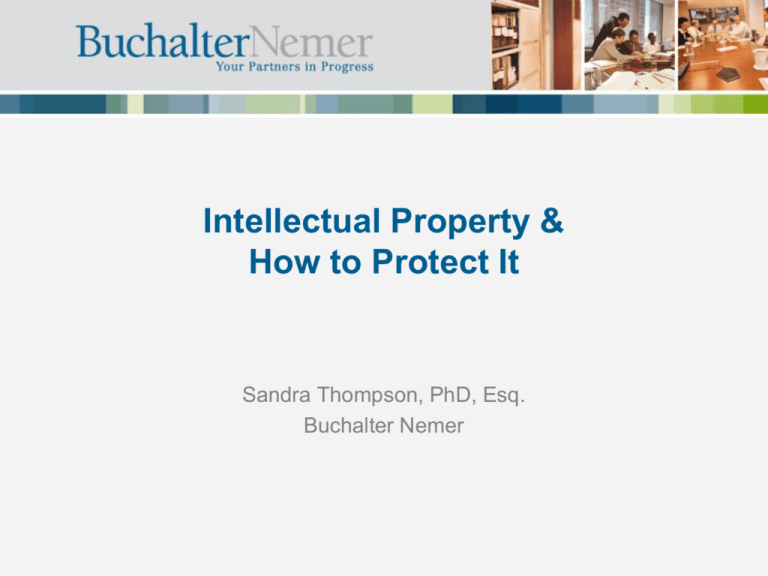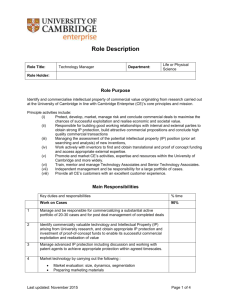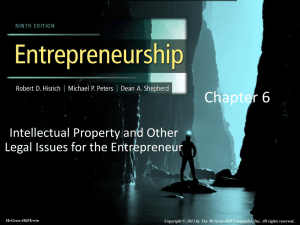The Inside-Outside Marketing Plan
advertisement

Intellectual Property & How to Protect It Sandra Thompson, PhD, Esq. Buchalter Nemer Where to Begin Vision Goals Objectives Strategies Tactics Metrics Where to Begin Vision: Make better vegans Goals: Provide accessible resources for new vegans Objectives: Online resources, tailored/customizable resources by the end of 2014; subscription model by 2015 Strategies: Develop or identify web-platform that can fit needs of customization and resource management; Develop and solidify branding; identify various partnership groups Tactics: On-line advertising or endorsement of a brand through celebrities; put together resources from respected nutritionists, vegan athletes and vegan celebrities. Metrics: page views, subscriptions Where to Begin Structure – Corporate, Ownership, Taxes Money – Venture, SBA, Loans, Grants Intellectual property What are the forms of IP? • Patents • Trade Secrets & Know How • Copyrights • Trademarks, Service Marks & Trade Dress • Domain Names What do the forms of IP protect? • Patents – Protect ideas: new, useful and non-obvious inventions. • Trade Secrets & Know How – Protect ideas and information. • Copyrights – Protect the expression of ideas. • Trademarks – Protect against confusion as to source or origin of goods or services. • Domain Names – Your address on the Internet. Examples • Trademarks COCA-COLAHP PFIZER INTEL INSIDE “Swoosh” • Service Marks GOOGLE BANK OF AMERICA • Trade Dress Coca-Cola Bottle McDonald’s “Golden Arches” Restaurants Patent Examples • Trade Secrets Coca-Cola Formula Search engine algorithms • Copyrights Movies, Websites, Paintings, Books, Photos, Articles, Computer Programs, Music • Patents Food Processor No. 4,541,573 Cheesecake Wedge No. D300,380 Compounds No. 3,790,670 Who owns IP (initially)? • • • • • Patents – Inventors Trade Secrets & Know How – Creators and controllers Copyrights – Authors Trademarks – User of the mark Domain Name – Registrant How long does protection exist? • • • • • Patents – Utility – 20 years from filing date Trade Secrets & Know How – As long as it remains secret Copyrights – Life of Author + 70 years or 95 years from creation Trademarks – For as long as the mark is in use Domain Names – For as long as registration is maintained Where to Begin Vision: Make better vegans Goals: Provide accessible resources for new vegans Objectives: Online resources, tailored/customizable resources by the end of 2014; subscription model by 2015 Strategies: Develop or identify web-platform that can fit needs of customization and resource management; Develop and solidify branding; identify various partnership groups Tactics: On-line advertising or endorsement of a brand through celebrities; put together resources from respected nutritionists, vegan athletes and vegan celebrities. Metrics: page views, subscriptions Small/Mid-Size Business New Business Few or No Employees Intellectual Property/Trade Secrets Protecting Your Inventions Limited Budget/Limited Resources Small/Mid-Size Business Independent Contractors Agreements – California and the “Work for Hire” Provision Employment Agreements – Intellectual Property Assignments – Leaving the Company Issues Your Business Considerations – Marriage In, Divorce Out Corporate Disclosure Process Corporate/Intellectual Property Committee Meets regularly Reviews new/proposed intellectual property, employment and contractor decisions Reviews invention disclosures Reviews current and long term IP budget Tracks decisions Corporate/IP Committee Management, Sales, Patent Counsel, Technical Meets Regularly Reviews potentially patentable developments Strategizes as to importance, resources, viable prosecution routes, enforceability, freedom to practice Document inventions, disclosures, trade shows and meetings, presentations, sales pitches and samples Agreements and contracts Review Contracts and Agreements Employee agreements Intellectual property agreements Independent contractor agreements Assignments to company License Agreements Other Information Offered for Sale? Sampled? Upcoming/Past Meeting/Tradeshow? Collaboration? Date of completion of form Signatures of technical team & witness Invention Disclosure System Form based Web based (good for multiple locations) Individual number assigned to each one Easily tracked Easily referred to in minutes Key words, grouping inventors Classification of Information Patent application Continuing patent application Defensive publication Trademark Copyright Trade secret Trade Secrets Designed to keep some processes or materials from the public long term Saves money with respect to IP budget Employee turnover Proof of “leak” – usually circumstantial Proof that company protected secret (normal business practices) AIA now encourages use of trade secrets Provisional Patent Application Not Examined by USPTO Not Published Allows Applicant to use “Patent Pending” Only pending for 1 year from filing Does not count toward 20-year patent term Utility Patent Application Considered “typical” patent application Background, Detailed Description, Examples, Claims Best Mode Necessary Assigned to Technology Group & Examiner Published 18 months after filing The Inventor(s) Should you call them “Inventors”? Consider “Technical Team” or “Technical Contributors” Order isn’t significant with respect to USPTO or foreign patent offices Home addresses, good contact information Alternate E-mail addresses Itemize Employment Agreements, consider keeping with disclosures Inventorship “Who are the inventors?” What is on the disclosure form? Incorrect inventorship = can be corrected, can result in invalidating issued patent (court looks at intent) Inventorship is also linked to ownership of the patent – each owner has an undivided interest in the patent – no matter the % contribution, unless otherwise modified between the patent owners. Community Property State? Transfer of Ownership? Review Contracts and Agreements Employee agreements Intellectual property agreements Independent contractor agreements Assignments to company License Agreements Inventorship Inventorship v. Peer Review Inventors for Joint Agreements Company President?? Group leaders? Inventor who has left the company? Is this person listed on the company disclosure? Proving Inventorship Laboratory Notebooks Meeting/collaboration notes E-mails/memos Computer files Publications/journals Abstracts/meeting presentations The Idea or Concept • You do not need to reduce it to practice • You should not publicize it – publish, local or national meeting, internet • You should report it to the right place at the Company or University and use the right format/form • You should document your work, who you worked with and who made what contributions to the concept or invention • If you know of any journal articles, work or patents that are close or in the same field as what you are doing – keep a list and submit it with your invention disclosure What a Company or University Needs in Place • Policy Framework • Intellectual Property Committee that meets regularly • Online, web-based system for inputting and date-stamping invention disclosures • Internal or External system for tracking submitted and published articles, internet publications, presentations and meetings attended by professors and graduate students • Regular training and “IP Alerts” Thank you!! Sandra Thompson, PhD, Esq. Buchalter Nemer sthompson@buchalter.com (949)224-6282 (direct) (949)224-6203 (fax) www.Buchalter.com




